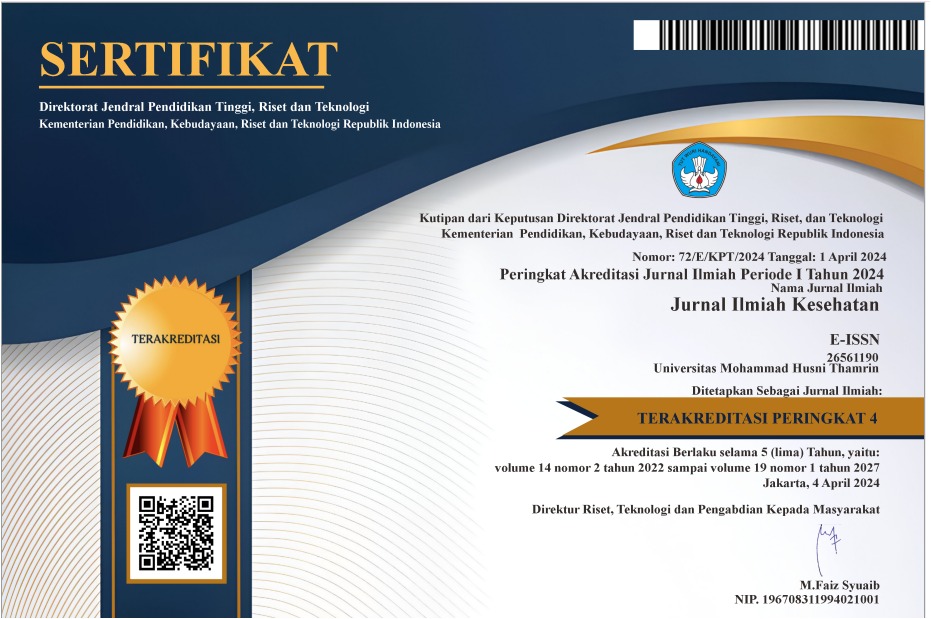Positive Blood Culture as a Marker of Sepsis and MODS Risk in Critically Ill Children A Narrative Literature Review
DOI:
https://doi.org/10.37012/jik.v17i2.3063Keywords:
Blood culture, Critically ill children, Pediatric sepsis, Time to positivity, Organ dysfunctionAbstract
Blood culture is an essential examination for establishing the diagnosis of bloodstream infection (BSI) in critically ill children, as it enables the detection of causative pathogens and guides appropriate antimicrobial therapy. This study aims to examine the association between positive blood culture results and disease severity in children admitted to the pediatric intensive care unit (PICU). A literature review was conducted by searching articles in PubMed, Google Scholar, NCBI, and ScienceDirect over the past 15 years, which were then selected based on topic relevance and methodological quality. Analysis of ten studies revealed that positive blood cultures were strongly associated with increased mortality, longer hospital stay, and a higher incidence of multiple organ dysfunction. Frequently reported risk factors included younger age, the use of central venous catheters, immunocompromised conditions, and infections caused by drug-resistant Gram-negative bacteria. Parameters such as time to positivity (TTP), procalcitonin levels, and organ dysfunction scores (PELOD-2) were identified as important prognostic indicators reflecting infection severity. Thus, a positive blood culture serves not only as a diagnostic tool but also as a crucial prognostic marker for risk stratification and clinical decision-making in critically ill children.
References
Bernardi, L. et al. (2024) ‘Biomarkers for Serious Bacterial Infections in Febrile Children’, Biomolecules, 14(1). doi: 10.3390/biom14010097.
Bettany-Saltikov, J. (2018) How to do a systematic literature review in nursing: A stepby-step guide. Maidenhead: McGraw-Hill/Open University Press.
Carcillo, J. A. et al. (2017) ‘Pathophysiology of pediatric multiple organ dysfunction syndrome’, Pediatric Critical Care Medicine, 18(3), pp. S32–S45. doi: 10.1097/PCC.0000000000001052.
Clemens, N. et al. (2024) ‘Association between positive blood culture and clinical outcomes among children treated for sepsis in the emergency department’, American Journal of Emergency Medicine, 76, pp. 13–17. doi: 10.1016/j.ajem.2023.10.045.
Dierig, A. et al. (2018) ‘Time-to-Positivity of Blood Cultures in Children With Sepsis.’, Frontiers in pediatrics. Switzerland, 6, p. 222. doi: 10.3389/fped.2018.00222.
Guo, B. C. et al. (2023) ‘Predictors of bacteremia in febrile infants under 3 months old in the pediatric emergency department’, BMC Pediatrics, 23(1). doi: 10.1186/s12887-023-04271-z.
Hall, R. T. et al. (2013) ‘Reducing the blood culture contamination rate in a pediatric emergency department and subsequent cost savings’, Pediatrics. American Academy of Pediatrics Elk Grove Village, IL, USA, 131(1), pp. e292–e297.
Han, H. J., Kim, K. and Park, J. D. (2024) ‘Early detection of bloodstream infection in critically ill children using artificial intelligence’, Acute and Critical Care, 39(4), pp. 611–620. doi: 10.4266/acc.2024.00752.
Hazwani, T. R. et al. (2020) ‘Association Between Culture-Negative Versus Culture-Positive Sepsis and Outcomes of Patients Admitted to the Pediatric Intensive Care Unit’, Cureus. doi: 10.7759/cureus.9981.
He, M. et al. (2024) ‘Prognostic significance of blood immune cells in children with sepsis and establishment of a predictive model for PICU mortality: a retrospective study’, Frontiers in Pediatrics, 12. doi: 10.3389/fped.2024.1455216.
Heilmann, E., Gregoriano, C. and Schuetz, P. (2019) ‘Biomarkers of Infection: Are They Useful in the ICU?’, Seminars in Respiratory and Critical Care Medicine, 40(4), pp. 465–475. doi: 10.1055/s-0039-1696689.
HK, C. et al. (2019) ‘Approach to Positive Blood Cultures in the Hospitalized Patient: A Review’, Missouri medicine, 116(4), pp. 313–317.
Issa, V. (2005) ‘Clinical impact of positive blood cultures in intensive care patients’.
Jacobs, L. and Wong, H. R. (2016) ‘Emerging infection and sepsis biomarkers: will they change current therapies?’, Expert Review of Anti-Infective Therapy, 14(10), pp. 929–941. doi: 10.1080/14787210.2016.1222272.
Jain, K. K. (2017) ‘Biomarkers of Infectious Diseases’, The Handbook of Biomarkers, pp. 219–238. doi: 10.1007/978-1-4939-7431-3_9.
Jennifer, D. B. and Erin, M. T. (2016) ‘Diagnosis of Bloodstream Infections in Children’, Journal of Clinical Microbiology. American Society for Microbiology, 54(6), pp. 1418–1424. doi: 10.1128/jcm.02919-15.
Lin, P. C. et al. (2022) ‘Revisiting factors associated with blood culture positivity: Critical factors after the introduction of automated continuous monitoring blood culture systems’, Medicine (United States), 101(30), p. E29693. doi: 10.1097/MD.0000000000029693.
M., P. et al. (2012) ‘Predictors of positive blood cultures in critically ill patients: A retrospective evaluation’, Croatian Medical Journal, 53(1), pp. 30–39.
Maia dos Santos, M. L. B. et al. (2022) ‘Prognostic Factors of Severely Ill Children with Klebsiella pneumoniae Carbapenemase Blood Stream’, Int J Nurs Health Care Res, 5, p. 1274.
Meena, D. S. et al. (2025) ‘Impact of blood culture positivity on clinical outcomes in sepsis: a prospective observational study’, Infezioni in Medicina, 33(3), pp. 294–302. doi: 10.53854/liim-3303-6.
Miranda, M. and Nadel, S. (2023) ‘Pediatric Sepsis: a Summary of Current Definitions and Management Recommendations’, Current Pediatrics Reports, 11(2), pp. 29–39. doi: 10.1007/s40124-023-00286-3.
Miura, S., Katsuta, T. and Nakamura, Y. (2024) ‘Predictive biomarker of mortality in children with infectious diseases: a nationwide data analysis’, Frontiers in Pediatrics, 12(July), pp. 1–7. doi: 10.3389/fped.2024.1381310.
Morin, L. et al. (2022) ‘The Current and Future State of Pediatric Sepsis Definitions: An International Survey’, Pediatrics, 149(6). doi: 10.1542/peds.2021-052565.
Nahar, A. et al. (2023) ‘Procalcitonin versus C-Reactive Protein as a Biomarker for Prediction of Bacterial Infection in Children with Febrile Neutropenia in Acute Leukemia.’, Mymensingh medical journal : MMJ, 32(1), pp. 76–82.
Nowak, M. et al. (2023) ‘One Hundred Consecutive Neutropenic Febrile Episodes Demonstrate That CXCR3 Ligands Have Predictive Value in Discriminating the Severity of Infection in Children with Cancer’, Children, 10(1). doi: 10.3390/children10010039.
Ogunkunle, T. O. et al. (2022) ‘A Prospective Cohort Study of the Clinical Predictors of Bacteremia in Under-Five Children With Acute Undifferentiated Fever Attending a Secondary Health Facility in Northwestern Nigeria’, Frontiers in Pediatrics, 9(February), pp. 1–10. doi: 10.3389/fped.2021.730082.
Omaggio, L. et al. (2024) ‘Utility of C-reactive protein and procalcitonin in community-acquired pneumonia in children: a narrative review’, Current Medical Research and Opinion, 40(12), pp. 2191–2200. doi: 10.1080/03007995.2024.2425383.
Paquette, K. et al. (2021) ‘Neither Blood Culture Positivity nor Time to Positivity Is Associated with Mortality among Patients Presenting with Severe Manifestations of Sepsis: The FABLED Cohort Study’, Open Forum Infectious Diseases, 8(7). doi: 10.1093/ofid/ofab321.
Randolph, A. G. and McCulloh, R. J. (2014) ‘Pediatric sepsis: important considerations for diagnosing and managing severe infections in infants, children, and adolescents.’, Virulence. United States, 5(1), pp. 179–189. doi: 10.4161/viru.27045.
Richard J. Brilli FCCM, M. D. and Brahm Goldstein FCCM, M. D. (2005) ‘Pediatric sepsis definitions: Past, present, and future’, Pediatric Critical Care Medicine.
Schlapbach, L. J., Watson, R. S., et al. (2024) ‘International Consensus Criteria for Pediatric Sepsis and Septic Shock’, Jama, 331(8), pp. 665–674. doi: 10.1001/jama.2024.0179.
Schlapbach, L. J., Goertz, S., et al. (2024) ‘Organ Dysfunction in Children With Blood Culture-Proven Sepsis: Comparative Performance of Four Scores in a National Cohort Study’, Pediatric Critical Care Medicine, 25(3), pp. E117–E128. doi: 10.1097/PCC.0000000000003388.
Schmoke, N. et al. (2025) ‘Daily Surveillance Blood Cultures in Children Supported With Extracorporeal Membrane Oxygenation: Single-Center, Retrospective Cohort Study, 2021–2023’, Pediatric Critical Care Medicine, 26(4), pp. e447–e453. doi: 10.1097/PCC.0000000000003699.
Upperman, J. S. et al. (2017) ‘Specific etiologies associated with the multiple organ dysfunction syndrome in children: Part 1’, Pediatric Critical Care Medicine, 18(3), pp. S50–S57. doi: 10.1097/PCC.0000000000001048.
Woods-Hill, C. Z. et al. (2021) ‘Consensus Recommendations for Blood Culture Use in Critically Ill Children Using a Modified Delphi Approach’, Pediatric Critical Care Medicine, 22(9), pp. 774–784. doi: 10.1097/PCC.0000000000002749.
Woods-Hill, C. Z. et al. (2022) ‘Association of Diagnostic Stewardship for Blood Cultures in Critically Ill Children with Culture Rates, Antibiotic Use, and Patient Outcomes: Results of the Bright STAR Collaborative’, JAMA Pediatrics, 176(7), pp. 690–698. doi: 10.1001/jamapediatrics.2022.1024.
Xu, H. et al. (2020) ‘Prognostic role of time to positivity of blood culture in children with Pseudomonas aeruginosa bacteremia’, BMC Infectious Diseases, 20(1). doi: 10.1186/s12879-020-05257-3.
Yasechko, S. M. et al. (2024) ‘Time to Positive Blood Cultures among Critically Ill Children Admitted to the PICU’, Critical Care Explorations, 6(7), p. e1115. doi: 10.1097/CCE.0000000000001115.
Downloads
Published
How to Cite
Issue
Section
Citation Check
License
Copyright (c) 2025 Rafly Bayu Surya Wardhana, Arina Setyaningtyas, Rebekah Juniati Setiabudi, Neurinda Permata Kusumastuti

This work is licensed under a Creative Commons Attribution 4.0 International License.
Jurnal Ilmiah Kesehatan allows readers to read, download, copy, distribute, print, search, or link to the full texts of its articles and allow readers to use them for any other lawful purpose. The journal allows the author(s) to hold the copyright without restrictions. Finally, the journal allows the author(s) to retain publishing rights without restrictions Authors are allowed to archive their submitted article in an open access repository Authors are allowed to archive the final published article in an open access repository with an acknowledgment of its initial publication in this journal.

Lisensi Creative Commons Atribusi 4.0 Internasional.










